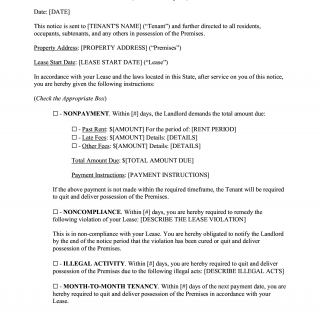Eviction Notice
An eviction notice is a legal document that landlords use to notify tenants to vacate their rental property. This notice is delivered in person, by registered post, or via another person who is of legal age staying in the rented property to hand it over to the main tenant. The purpose of the eviction notice is to inform the tenant of the conditions that have been violated and the amount of time given to take corrective action.
The eviction notice must contain the following important fields: the tenant's name, rental property description and location, reasons for the eviction, time given for the tenant to take action, and the landlord's signature with the date. In the case of missed rent payments, the amount of time given to the tenant can be as little as 7 days or less. Other violations such as property damage or abandonment may take longer to correct, so the eviction notice may specify 30 days or 60 days before further action is taken.
It's important to note that an eviction notice is not necessarily a legally enforceable document, so it can't be used to physically remove an unwanted or non-compliant tenant. Instead, it's a notice that informs the tenant of the landlord's intention to take legal action if corrective action is not taken.
When writing an eviction notice, the landlord must consider the state laws that govern the eviction process. This includes the specific language that must be used in the notice, the amount of time given to the tenant to take corrective action, and the process for filing the notice with the court.
To complete an eviction notice, the data required includes the tenant's name, the rental property description and location, and the specific reasons for the eviction. Depending on the state laws, additional documents may need to be attached to the notice, such as a copy of the lease agreement or proof of non-payment of rent.
Application examples of an eviction notice include situations where tenants have violated the terms of their lease agreement, failed to pay rent, or caused damage to the rental property. The strengths of an eviction notice include its ability to inform the tenant of the landlord's intention to take legal action and the specific corrective actions required to avoid eviction. The weaknesses of an eviction notice include the potential for legal challenges if the notice is not written correctly or if state laws are not followed.
An alternative form to an eviction notice is a notice to quit, which is used in some states to notify the tenant that their tenancy will be terminated if corrective action is not taken. The main difference between an eviction notice and a notice to quit is the amount of time given to the tenant to take corrective action.
The eviction notice affects the future of both the landlord and the tenant, as it can lead to legal action and potential financial consequences for the tenant. The notice must be submitted to the tenant in the correct manner, as specified by state laws, and stored as part of the rental property's legal records.

